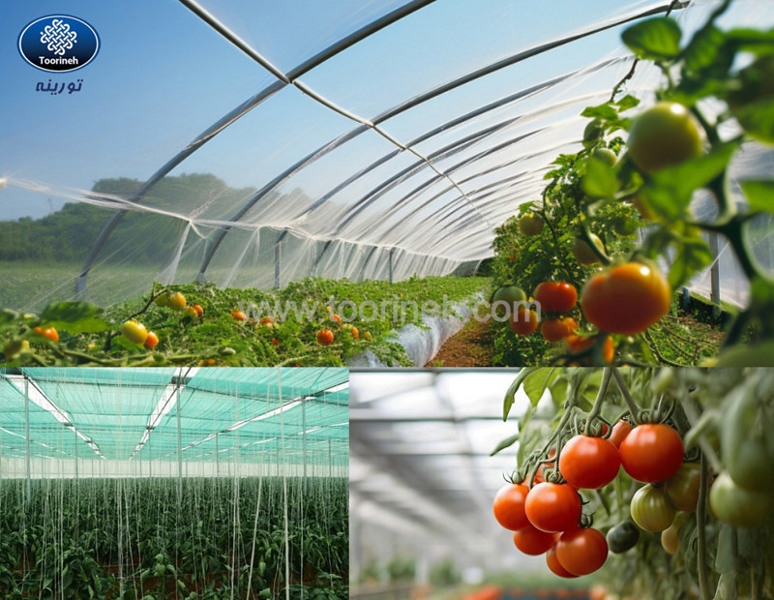
Choosing the Right Shade Net for Tomato Cultivation: Green or White? 30% or 50%?
Growing tomatoes can be both rewarding and challenging—especially when it comes to providing the right balance of sunlight and shade. Selecting the proper shade density and color for your shade net plays a vital role in optimizing tomato growth, fruit quality, and yield.
Is a 50% shade net too much for tomatoes, or is it the perfect solution for protecting them from intense sunlight? In this article, we’ll explore the impact of different shade nets on tomato cultivation and help you choose the ideal option for your farm or greenhouse.
1. Why Shade Matters for Tomato Plants
In hot and sunny climates, shade protection is essential for maintaining the health of tomato plants. Excessive sunlight can cause sunburn, uneven ripening, and heat stress—all of which reduce fruit quality and yield.
Protecting Tomatoes from Sunburn
Sunburn occurs when fruits are exposed to direct sunlight for too long, resulting in discoloration and tissue damage. A shade net blocks excessive UV radiation, reducing the risk of sunburn and preserving the natural color and texture of the fruit.
Promoting Uniform Ripening
Excessive heat can lead to uneven ripening and poor flavor. By filtering sunlight, shade nets help create a stable microclimate, ensuring that tomatoes ripen evenly with a more appealing appearance and better taste.
Reducing Heat Stress
During peak summer, extreme temperatures can severely affect tomato plants. Shade nets lower the internal canopy temperature, protecting plants from heat stress and supporting consistent fruiting even under challenging conditions.
Improving Moisture Retention
Shade nets also reduce water loss through evaporation and transpiration, helping plants retain more moisture. This means healthier plants and improved water-use efficiency, which is especially beneficial in arid climates.

2. Understanding Shade Density: Is 50% Too Much?
The percentage of shading determines how much light reaches the plants. For tomatoes, a shade net with 30% to 50% density is generally ideal. While 30% nets allow more sunlight for photosynthesis, 50% nets offer stronger protection in regions with extreme heat.
Signs that tomatoes are receiving too little light include elongated stems, pale leaves, and slow growth. If these occur, switching to a lower density shade net may be beneficial.
3. Green vs. White Shade Nets: Which Is Better?
Different shade net colors affect light diffusion and temperature in unique ways. Choosing the right color depends on your regional climate and cultivation goals.
• Green or Black Nets: Provide strong shading and are ideal for high-temperature regions. However, they may slightly increase heat absorption.
• White Nets: Reflect more sunlight and reduce internal temperatures. They are perfect for maintaining cooler growing environments and ensuring uniform light distribution.
• Aluminet (Reflective Nets): Offer excellent heat reduction and light diffusion—ideal for professional greenhouses.
At Toorineh Baft, our shade nets are made using premium European UV stabilizers to ensure durability and performance under harsh sunlight. Each product offers a long service life of 5 to 7 years and a 36 to 48-month UV warranty.

4. Best Practices for Installing Shade Nets in Tomato Fields
Proper installation ensures maximum efficiency. Keep these key points in mind:
• Install the shade net 1.5–2 meters above plants to maintain airflow.
• Secure the net firmly with clips or ropes to withstand strong winds.
• Avoid full coverage during early morning or late afternoon to allow pollinator activity.
• Monitor temperature and humidity regularly to maintain optimal conditions.
5. Using Shade Nets in Greenhouses and Plastic Tunnels
In controlled environments like greenhouses, shade nets can be applied above or inside the structure to regulate light and temperature. Adjustable shading systems provide flexibility throughout the day, ensuring ideal conditions for photosynthesis and fruit development.
6. Key Benefits of Shade Nets for Tomato Cultivation
• Protect plants from excessive heat and UV damage
• Promote uniform fruit ripening and quality
• Reduce water evaporation and save irrigation costs
• Enhance pollination efficiency under moderate temperatures
• Extend the overall growing season in hot climates
Conclusion
Choosing the right shade net—whether 30% or 50%, green or white—depends on your region’s climate and growing setup. For areas with extreme sunlight, a 50% white shade net is often the best balance between protection and productivity.
By using high-quality shade nets from Toorineh Baft, you can protect your tomato plants from sunburn and heat stress, conserve water, and achieve consistent, high-quality harvests year after year.
Toorineh Baft – Premium Shade Nets for Agricultural and Construction Applicatio
Visited: 188



